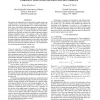Free Online Productivity Tools
i2Speak
i2Symbol
i2OCR
iTex2Img
iWeb2Print
iWeb2Shot
i2Type
iPdf2Split
iPdf2Merge
i2Bopomofo
i2Arabic
i2Style
i2Image
i2PDF
iLatex2Rtf
Sci2ools
ICIP
2005
IEEE
2005
IEEE
Chromatic adaptation and white-balance problem
The problem of adjusting the color such that the output image from a digital camera, viewed under a standard condition, matches the scene observed by the photographer’s eye is called white-balance. While most white-balance algorithms approach the problem using the coefficient law (von Kries), the coefficient law has been shown inaccurate. In this paper, we instead formulate the white-balance problem using Jameson and Hurvich’s induced opponent response chromatic adaptation theory. The solution to this white-balance problem reduces to a single matrix multiplication. The experimental results using existing illuminant estimation methods verify that the induced opponent response approach to solving the white-balance problem yields more neutral colors in the white panels of the Macbeth color chart than the traditional methods. The computational cost of the proposed method is virtually zero.
ICIP 2005 | Image Processing | Opponent Response | White-balance Problem | White-balance Problem Yields |
| Added | 24 Jun 2010 |
| Updated | 24 Jun 2010 |
| Type | Conference |
| Year | 2005 |
| Where | ICIP |
| Authors | Keigo Hirakawa, Thomas W. Parks |
Comments (0)

